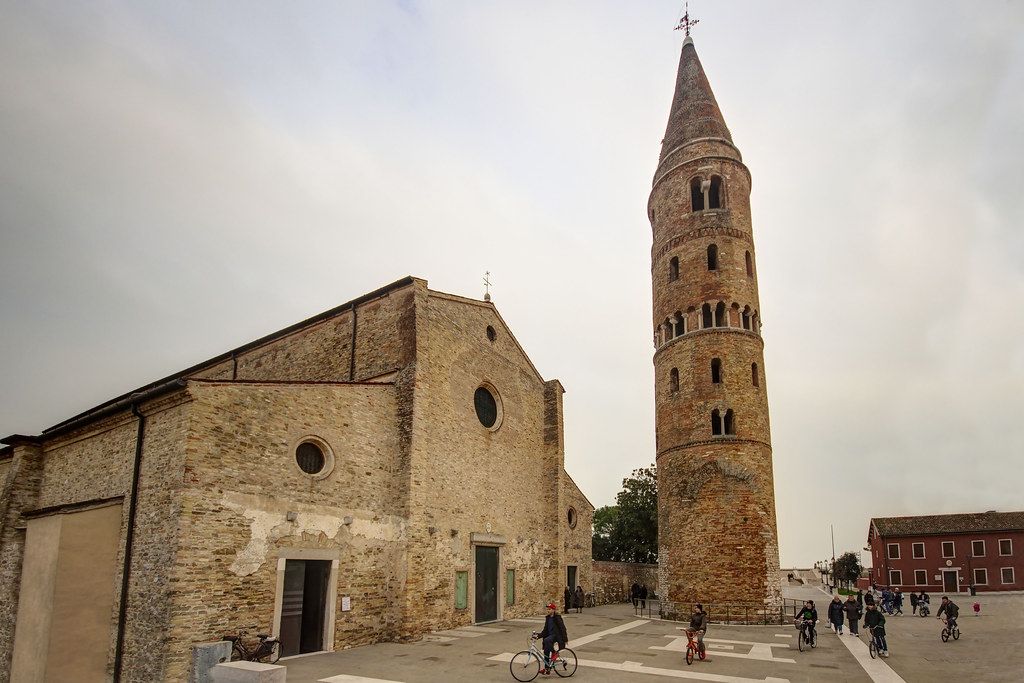Caorle is a small seaside resort located on the shores of the Upper Adriatic, halfway between Venice and Trieste. While in summer, Caorle is crowded with tourists who come for its golden sand and the safe waters of its sea. For the rest of the year, the city remains a perfect destination for a day trip to breathe the sea air and stroll through its narrow streets that offer picturesque views, perhaps with a cone of fried fish to nibble on.

Things to do in Caorle every season
Whether you visit in summer, winter, or any other season, there is always plenty to do and see in Caorle. Its past is intertwined with the history of the Venetian Republic, which is still clearly visible in the architecture and layout of the historic center. Maritime traditions are included in every aspect of the town’s life, keeping legends, customs, and especially enviable cuisine alive. The natural environment in which Caorle is situated gives it a richness and uniqueness of habitat that is hard to find in other tourist destinations.
Historic center of Caorle
The first thing to see in Caorle is undoubtedly its picturesque historic center. The heart of Caorle strongly resembles Burano, the most colorful of the Venetian islands, with which it shares the pastel shades of the houses and the narrow alleys. Caorle’s historic center is centrally located between the two beautiful beaches, the Levante beach and the Ponente beach, which flank it to the east and west, while to the south, it overlooks the sea with a pleasant promenade lined with large boulders reinterpreted by artists with abstract forms, animals, or people.
Getting lost in the alleys of the historic center in search of cute corners to photograph is undoubtedly one of many things to do in Caorle. During a quiet stroll, especially around lunchtime, you will smell the aromas emanating from the restaurant kitchens, inviting you to stop and taste the delights of local cuisine. Although Caorle is primarily a tourist center today, it was a fishing village in the past. Therefore, its cuisine features many recipes using fish from the Adriatic Sea and the lagoon that have always been caught in its waters.
Visit the Cathedral and the cylindrical bell tower
Among the most significant buildings in Caorle’s historic center, what stands out above all is the Cathedral flanked by its cylindrical bell tower. Built around the year 1000 in Romanesque style, the Cathedral of Caorle has a very simple external facade. Even the interior, with its three naves separated by round arches, is quite simple but still features interesting altars, statues, paintings, and masterpieces that are worth admiring.

Adjacent to Caorle Cathedral is the Treasure Museum of Caorle Cathedral, the former bishop’s chapel now transformed into a permanent exhibition containing important relics and precious sacred furnishings that have made the history of the Cathedral. On Piazza Vescovado, the square in front of the Cathedral, the bell tower rises majestically with its distinctive cylindrical shape. It is 48 meters high and slightly leaning, and it was built at a similar time as the church.
The bell tower, probably originally built as a watchtower, can be visited by reservation to admire a beautiful view of the city and the sea. In summer (from June to September), it is possible to take part in guided tours of the Cathedral and the museum for free. But, if you want to climb the bell tower, you will have to pay for the ticket, which costs 3 euros.
Take a walk along the promenade
The Adriatic Sea is a short walk from the Cathedral and its bell tower, and you can walk by the sea to reach the church of Madonna dell’Angelo. Caorle’s promenade is completely pedestrianized and lively throughout the year. Most visitors, but locals too, every Sunday stroll along the promenade and breathe in the scent of the sea. One of the attractions of Caorle’s promenade is its cliff, the Living Cliff.
It is an initiative that brings artists from all over the world to Caorle every year to sculpt the large boulders that protect the promenade from the sea, giving them life with their sculptures. So while walking, you can come across human faces or bodies, animals, and abstract figures that intrigue both adults and children.
Visit the church of Madonna dell’Angelo
The most beloved place by both locals and tourists is definitely the Church of Madonna dell’Angelo, a sanctuary located on a small natural elevation overlooking the Adriatic Sea. This church is truly a place of the heart, not only for the people of Caorle but also for many tourists and “outsiders” who come to pray to the Madonna, ask for grace, or make a vow. The church is also one of the favorite places to celebrate weddings. Its position so close to the sea makes it a romantic place, a dream for many brides and grooms.

The existence of this church, erected by fishermen in honor of the Madonna, has a very long history that is linked to the legend. There is a celebration and historical reenactment that takes place every 4 years in Caorle and for the occasion, the whole town is blue, which is the color of the Madonna.
Visit the fishermen’s lodges of Caorle
Among the things to do in Caorle, you absolutely must not miss the Isola dei Pescatori. It is the place overlooking the lagoon where you can explore lovely fishermen’s lodges. These lodges are the ancient lagoon huts of the fishermen, buildings made of reeds that were old shelters for fishing in the lagoon during the coldest seasons. However, they are also very simple homes for fishermen’s families in certain periods of the year.
Nowadays, these lodges remain interesting buildings to admire during a bike ride or a boat trip in the lagoon, but they have lost their old function, becoming summer retreats to get away from the beach chaos. Some lodges are used for evenings and barbecues with friends, or in some cases, they have been transformed by their owners into holiday homes.
Discover the cuisine of Caorle
Caorle is a town with a long fishing tradition. Its inhabitants were fishermen for many centuries, but today it is known as vacation place for many tourists. This means that fish has always played a very important role in the life of the town, and the lively fish market is still a beautiful testimony to this. The fish from Caorle is very delicious and there is a wide choice of different types of catch throughout the year.
Therefore, local cuisine has learned to transform this product into many delicious dishes that are amazingly good. These are mostly simple dishes that were part of the everyday meal for fishermen and their families, some of which have a lot in common with the culinary traditions of neighboring seaside resorts. You can choose anything from mixed fried fish to fish risotto, from stewed mantis shrimps to sardines in “saor”, passing through more traditional dishes like broetto de seppe (a kind of red broth thickened with cuttlefish) and boiled baby octopuses.
Baby octopuses, in particular, are a typical product of Caorle, which can be caught especially off its coasts. Furthermore, they are very similar to small octopuses and are delicious in all ways, but especially boiled with potatoes. Given the great culinary tradition of Caorle, you won’t have a hard time finding good restaurants where you can taste the local specialties.
Visit Valle Vecchia
Wandering a little away from Caorle, but remaining close as the crow flies, there is the natural oasis of Valle Vecchia, which is certainly one of the best places to see near Caorle. This coastal nature reserve located beyond the mouth of the Nicesolo Canal is surrounded by the lagoon environment (with its characteristic flora and fauna), a large pine forest, and a beach left in its natural state. In Valle Vecchia, you can indeed freely access Brussa Beach, one of the few beaches on the Adriatic that maintains its original appearance and where you can still see sand dunes that form naturally with the action of the wind.

Access to the Valle Vecchia Oasis is free, although parking is paid. There are no services of any kind here, and visitors are required to show maximum respect for the beach and the surrounding pine forest areas. In the forest, there are paths to walk or cycle, and beautiful birdwatching spots from which you can admire many species of animals, especially birds, that nest or inhabit these areas.
Check out more articles about Italy:
- The best of Venice in 24 hours
- Venice in one day from Santa Lucia station
- Things to do on New Year’s Eve in Venice
- Why you should visit the Jewish ghetto in Venice
- Best pastry shops in Venice
- How to get to Venice?
- Walk among contemporary architecture in Venice
- Local markets of Sicily
- Best budget-friendly places to stay on Amalfi Coast
- Best beaches in Elba Island
- Things to do on Lake Como

